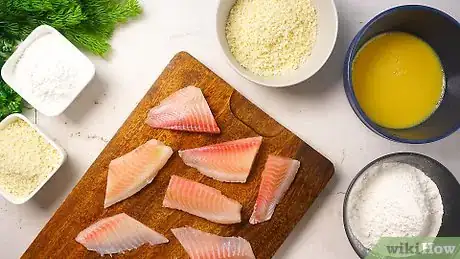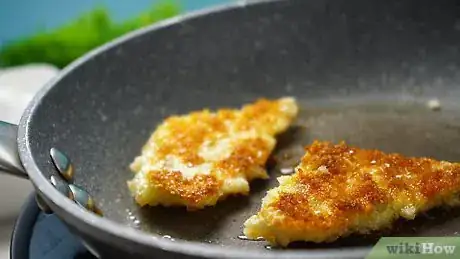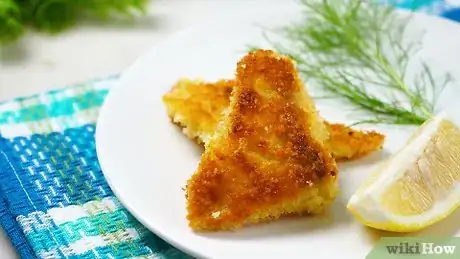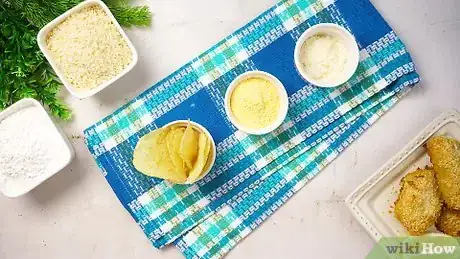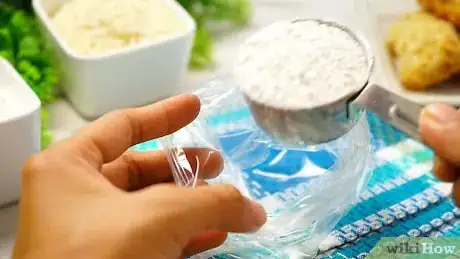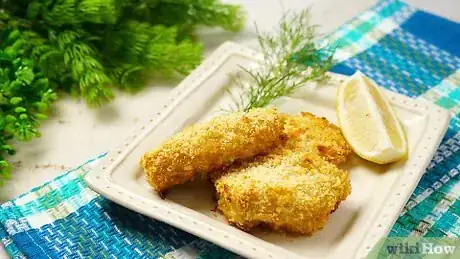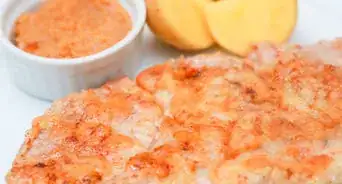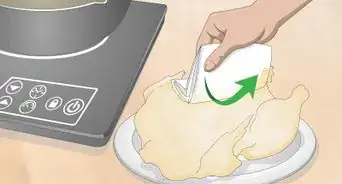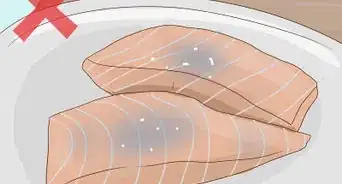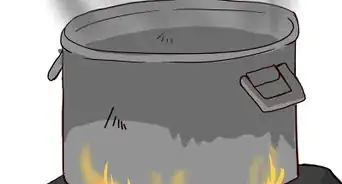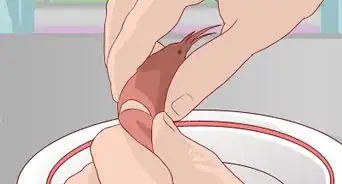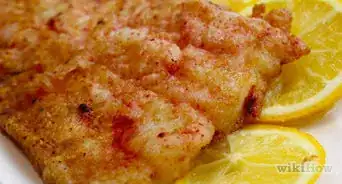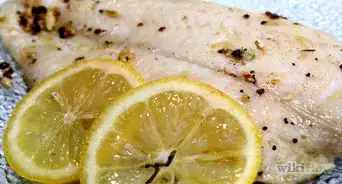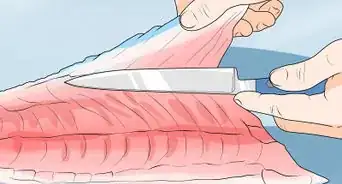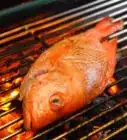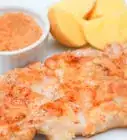This article was co-authored by wikiHow Staff. Our trained team of editors and researchers validate articles for accuracy and comprehensiveness. wikiHow's Content Management Team carefully monitors the work from our editorial staff to ensure that each article is backed by trusted research and meets our high quality standards.
The wikiHow Culinary Team also followed the article's instructions and verified that they work.
This article has been viewed 719,126 times.
Learn more...
Steps
The Basics
-
1Prepare your ingredients. A basic breading involves fish, flour, egg, and coating. If you're using frozen fish, defrost it thoroughly. It's also good to rinse the fish in cold, clean water to remove any scale-bits or other stuff that might be stuck to it. If you're using crackers or need to make your own bread-crumbs, take some time to crunch them up as thoroughly as possible. The smaller the crumb, the better the crust will be eventually. Beat 1-2 eggs into a bowl with a small amount of milk or water to smoothen out the mixture. For a basic breaded fish, prepare the following ingredients:
- Fish fillets of your choice. A white fish like tilapia or cod is usually better for breading.
- Flour
- Bread crumbs or cracker crumbs, seasoned
- 1-2 eggs, beaten
- Milk or water
-
2Pour ingredients into separate bowls. Pour cracker crumbs or other breading into one bowl, your flour into another bowl, and the beaten egg into yet another. It's usually helpful to have them in the order they'll be used. To one side of your skillet, line up the flour, then the egg, then the coating, which should be closest to the skillet.
- Take a minute to season your coating, if it isn't seasoned already. A pinch or two of salt and pepper are good additions, as well as cayenne pepper, seasoned salt, dill, or Old Bay seasoning. Use the kind of flavors you like and season the coating to your taste. Alternatively, you can season the flour.
Advertisement -
3Coat the fish in the flour. Take your fish fillets and dredge them in the flour thoroughly, using your hand to work flour into the nooks and crannies. This step is important to filling in the gaps in the cracker crust, working with the breading to form a nice and even coating.
-
4Dip the dredged fish in the egg mixture, then coat it with the breading. Don't drop it in to the egg mixture and soak it. Instead, dip it quickly and take it as cleanly and quickly as you can to the next "station" with the coating in it. Dip the fish into your seasoned coating and use your other hand to spread the coating over the fish evenly.
-
5Place coated fish into a frying pan. To fry your breaded fish, heat a half-inch or so of cooking oil on medium-high heat and fry the fish in it, turning once, about 3-5 minutes on each side. Turn the fish over when the crust has turned a golden brown color. It won't take long, so watch carefully.
- Wait until the oil is hot enough (about 350 degrees) before adding the fish. It should feel hot with your hand 3–5 inches (7.6–12.7 cm) above it, and spit when you throw a drop of water into it. Avoid over-loading the frying pan with too many pieces of fish, or you'll drop the temperature considerably. Frying at a lower temperature results in oily and soggy fish.
- Alternatively, you can bake the fish. To bake your breaded fish, place your breaded fillets into a baking dish or onto a baking sheet. Bake at 375 °F (191 °C) for 15-20 minutes, turning halfway through.[1]
-
6Finish and serve. Breaded fish goes well with a squeeze of lemon, tartar sauce, malt vinegar, or all of the above. Prepare with fried potatoes for a classic fish-and-chips, or opt for a healthier option and serve with wild rice and green vegetables.
Some Alternatives
-
1Experiment with different breading combinations. Fish is versatile and amenable to all sorts of breading and combinations. You can use crunched up potato chips, potato flakes, cornmeal, or even corn flakes cereal, depending on what's available. Experiment some to see what you like best.[2]
- Skip the crumbs and dip twice in flour. If you're out of bread crumbs and don't feel like crunching up a bunch of crackers, feel free to do two coatings in seasoned flour instead of the regular one coating.
- The breading of choice for a southern-style fish-fry is definitely cornmeal. It makes a golden brown super-crunchy crust that's hard to argue with. If you've got some cornmeal or corn-flour on hand, give it a try.
-
2Bag up your dredging mix. Typically, when deep-frying fish, people will skip the egg batter and elect to head straight from the flour mix to the fryer. If you're doing a big batch, or just want to make the clean-up process easier, consider putting your seasoned flour AND your other breading mixture into a paper or plastic bag, adding your fish fillets, and closing the bag securely. Shake the bag until the fish are coated evenly and put immediately into the deep fryer.
-
3Try a beer-batter for a thick and crunchy crust. The batter used for deep-fried fish in Europe and elsewhere is commonly a wet batter, rather than a dry breading, and is delicious and easy to make. To create a wet batter for dipping fish into, mix together:
- One half-cup of flour
- One tsp. baking soda
- One-half tsp. salt
- Half-can or bottle of beer
- Seasoning, to taste
-
4Add lemon juice to lessen the "fishy" taste. If you're cooking a stronger fish like catfish or salmon in breading, or don't particularly like the taste of fish, adding a bit of lemon juice to the beaten egg can help to mask it slightly. Consider adding a squeeze of lemon to the egg when cooking for picky fish eaters.
-
5Finished.
Community Q&A
-
QuestionWhen cooking fish with cornmeal, do I need to use flour as well as the eggs?
 Community AnswerMix equal parts flour and cornmeal and season it a bit. Dip fish into beaten egg, then into flour/cormeal/seasoning mixture. The result will be a thin crunchy layer over flaky fish.
Community AnswerMix equal parts flour and cornmeal and season it a bit. Dip fish into beaten egg, then into flour/cormeal/seasoning mixture. The result will be a thin crunchy layer over flaky fish. -
QuestionCan I fry the fish the night before and reheat it the next day?
 Community AnswerYes, but it might ruin the texture and quality of the fish. It might not be as crispy as when you fried it.
Community AnswerYes, but it might ruin the texture and quality of the fish. It might not be as crispy as when you fried it. -
QuestionCan I use some kind of nut breading?
 C GraceCommunity AnswerYes, you can grind up your favourite type of nut and mix it in with breadcrumbs or use it by itself.
C GraceCommunity AnswerYes, you can grind up your favourite type of nut and mix it in with breadcrumbs or use it by itself.
Warnings
- Keep your face away from the pan when you add the fish and be very careful of "spitting" oil. It's very hot, so use extreme caution. Turn it down some if it starts smoking.⧼thumbs_response⧽
Things You'll Need
- Two bowls
- Tongs
- Baking dish or frying pan
References
About This Article
To bread fish, first crack 3 large eggs in a bowl and whisk them thoroughly. Fill a separate bowl with bread crumbs and another bowl with all-purpose flour. Then, dry off your thawed fish filets with paper towels. Take the first filet and dip both sides in the flour so it's completely coated. Then, dip both sides of the filet in the egg mixture. Don't worry if a little flour comes off. Finally, dip both sides of the filet in the bread crumbs. Place each filet on a plate when you finish breading it. To pan fry the fish, first spread 1-2 teaspoons (5-10 mL) of oil around in a pan. Place the filets in the pan and cook them over medium-high heat for 3-10 minutes depending on how thick they are. Then, flip the filets over and cook the other side for 3-10 minutes. To bake the filets in the oven, first preheat your oven to 375 °F (190 °C). Line a baking sheet with aluminum foil and spray it with non-stick cooking spray. Then, set the filets on the sheet and bake them in the oven for 10-20 minutes depending on how thick they are. Read the article for more tasty ideas, including different seasoning options!
